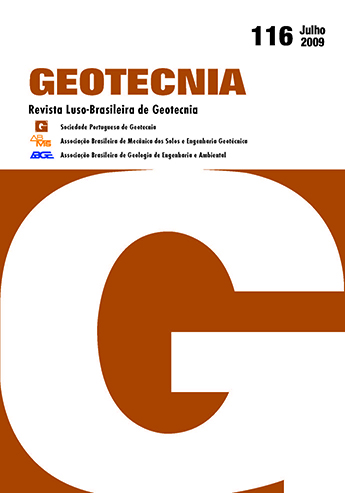Geotechnical characterization and shear resistance behavior of pre-treated solid wastes
DOI:
https://doi.org/10.14195/2184-8394_116_6Keywords:
Solid waste, Mechanical biologic pre-treatment, Shear strength, Fiber effectAbstract
Tests were performed to charaterize and to determine the mechanical properties of biologic pre treated solid wastes collected from the cities of São Sebastião/SP and Novo Hamburgo/RGS, Brazil. High fiber content (plastics, wood, etc.) in the coarse part of the waste was verified (larger than 2 mm). In the fibrous material it was observed a larger amount 1D shape elements. Direct shear tests were performed in samples in dense and loose state and no peak shear resistance were observed. All performed tests show increasing shear resistance with deformation. Tri-linear shear resistance envelopes for both wastes were observed. Increase amount of fibers and waste compaction promote an effective apparent cohesion increase, but no significant variation of values of waste friction angle was observed. This mechanical behavior is mainly due to the content of fibrous materials and consistent with the proposed model by Kolsch (1995).
Downloads
References
Associação Brasileira de Normas Técnicas (2004). Resíduos sólidos – classificação: NBR 10004. Rio de Janeiro, Brasil, 71p.
Barros, R.T., Gariglio, L.P., Keller, W., Loureiro, C. de O., Melo, G.C.B. de, Batista, H. e Goulart, A.F. (2000). Landfill monitoring methodology the experience of Belo Horizonte (MG). 5th
International Symposium on Global Sustainable Development Environmental Geotechnology. Belo Horizonte, MG.
Borgatto, A.V.A. (2006). Estudo do efeito fibra e da morfologia na estabilidade de aterros de resíduos sólidos urbanos. Dissertação de Mestrado, Programa de Engenharia Civil, Curso de Pós-Graduação em Engenharia, COPPE-UFRJ, 157p.
Calle, J.A., Ehrlich, M. e Mahler, C. (2005). Geotechnical behavior of mechanically biologically pretreated residual waste. International Conference on Energy, Environment and Disasters, INCEED 2005. Bridging the gaps for global sustainable development (UNESCO ISEG GADR). Charlotte, North Carolina, Estados Unidos.
Carvalho, A.R. (2006). Desenvolvimento de um equipamento para a determinação de parâmetros geotécnicos de resíduos sólidos. Tese de Doutorado, Programa de Engenharia Civil, Curso de Pós-Graduação em Engenharia, COPPE-UFRJ, 160p.
de Melo, V.L. e Juca, J.F. (2001). Diagnostico ambiental em aterros de resíduos sólidos a partir de estudos de referencia. 21° Congresso Brasileiro de Engenharia Sanitária e Ambiental, ABES, pp 16-21.
Gomes, R.C. (1993). Interação solo-reforço e mecanismos de ruptura em solos reforçados com geotextil. Tese de Doutorado, Programa de Engenharia Civil, Universidade de São Paulo, 270p.
IPT, CEMPRE (2000). Lixo municipal-manual de gerenciamento integrado. São Paulo, 246p.
Izzo, R.L. dos S., Borgato, A.V.A. e Mahler, C.F. (2006). Classificação de resíduos sólidos urba - nos da Cidade do Rio de Janeiro utilizando a norma alemã E1-7 GDA. XIII Congresso Brasileiro de Mecânica dos Solos e Engenharia Geotécnica, COBRAMSEG.
Jessberger, H.L. (1994). Geotechnical aspects of landfill design and construction. part 1: principles and requirements. Proc. Instn Civ. Engrs Geotechnical. Engineering, v.107, apr. 99 - 104.
Junqueira, F.F. (2000). Análise de comportamento de resíduos urbanos e sistemas dreno-filtrantes em diferentes escalas, com referência ao aterro do Jóquei Clube. Tese de Doutorado, Depar - ta mento de Engenharia Civil e Ambiental, Programa de Pós-graduação em Geotecnia, Uni ver - sidade de Brasília, 283 p.
Kolsch, F. (1995). Material values for some mechanical properties of domestic waste. Proceedings of the 5th Sardinia International Landfill Symposium, S Margherita Di Pula, Cagliari, vol II.
Machado, S.L., Carvalho, M.F. e Vilar, O.M. (2000). Towards modelling municipal solid waste mechanical behaviour. International Conference on Geotechnical and Geological Engineering, Geoeng2000, Melbourne.
Mahler. C. F. (2002). Proposed Scientific follow-up of the Project of Mechanical Biological Treatment of Urban Solid Waste. Final Report. Fundação COPPETEC, for Faber Recycling and the German Ministry of Education and Research.
Manassero, M.; Van Impe, W. F. e Bouazza, A. (1996). Waste disposal and containment. In proceedings of the Second International Congress on Environmental Geotechnics, preprint of special lectures, Osaka, Japan, Balkema, vol.3, pp 1425-1474.
Monteiro, V. E., Juca, J. F. e Rego, C. (2001). Influência das condições climáticas no comporta - mento do aterro de resíduos sólidos da Muribeca. 21° Congresso Brasileiro de Engenharia Sanitária e Ambiental, ABES, pp 16-21.
Münnich, K.; Mahler, C. F. e Fricke, K. (2006). Pilot project of mechanical-biological treatment of waste in Brazil. Waste management (Elmsford), vol. 26, n.º 2, pp 150-157.
Schueler, A. S. de (2005). Estudo de caso e proposta para classificação de áreas degradadas por disposição de resíduos sólidos urbanos. Tese de Doutorado, Programa de Engenharia Civil, Curso de Pós-Graduação em Engenharia, COPPE-UFRJ, 223 p.
Silveira, A. M. (2004). Estudo do peso específico de RSU. Dissertação de Mestrado, Programa de Engenharia Civil, Curso de Pós-Graduação em Engenharia, COPPE-UFRJ, 106 p




